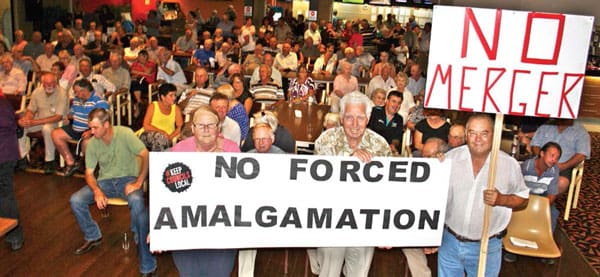Courtesy of the Gundagai Independent. Independently owned and operated newspaper est 1898.
With Gundagai mayor Abb McAlister vowing to “fight till the finish” in the face of a forced merger, close to 400 residents turned out in a show of support at last Thursday night’s public meeting.
The community sent a clear message, calling on State Member Katrina Hodgkinson to raise her voice and get behind her constituents as they fight to stave off a looming and unwanted merger with Cootamundra Shire Council.
Ms Hodgkinson’s absence at last week’s meeting, along with two previous meetings, was clearly greatly felt, with many believing Gundagai’s fight to remain independent can only be won now through political pressure.
“As shown at previous public meetings, Council and the Gundagai community is resolutely committed to retaining Gundagai Shire Council in its current form, and we urge our State Member Katrina Hodgkinson to fight against what we see will be detrimental to our iconic town and Council,” Mayor Abb McAlister said.
During the meeting, resident and business owner John Knight put forward a motion that “the community of Gundagai expresses its no confidence in its Local Member”, however the motion was later with- drawn.
Clearly frustrated and with a lot of support, Mr Knight said the community did not elect Ms Hodgkinson “to be a bystander”.
“Lead, follow or get out of the way,” Mr Knight said.
“It’s time we sent Katrina and the NSW government a message – we expect better from her and from them.”
The crowd heard that Council’s 10-year financial plan shows it to have $12.5 million in ready cash by 2025, up $7 million on its present figures.
“And over that 10 years we will have spent $14.9 million on major infrastructure projects,” Cr McAlister said.
“The state government has stated that a merger with Cootamundra Council will save $300,000 a year, over the two councils, being $150,000 per council. Gundagai Council’s 10-year financial budget shows that as a stand alone council,
we will save $560,000 per year, so it is economic sense that we remain a stand alone council.
“Council is not convinced that there are any tangible benefits from a merger that outweighs the risk of losing our local representation, identity and control of local issues and services, and this is informed by meetings with neighbouring councils, in-house and independent studies, and the very strong rejection of the merger option by our community.”
After the announcement from the Department of Premier and Cabi- net proposing a Gundagai/Cootamundra merger, Council engaged Dr Joseph Drew to undertake due diligence on the proposal.
Dr Drew, a Research Fellow in the Centre for Local Government at the University of New England, presented the outcome of his research at Thursday’s meeting.
He spoke of historical merger failures in Victoria, Queensland, New Zealand and Quebec, saying
mergers do not deliver “the bene- fits you read about prior to amalgamation”.
Dr Drew, whose full report can now be viewed on Council’s web- site, criticised the state government for not yet releasing the KPMG fig- ures used to justify the proposed Gundagai/Cootamundra merger, instead releasing a technical paper, outlining financial modelling ‘as- sumptions’ for the State.
“When you make an assumption without evidence, it’s just a guess,” he said.
He said, in all likelihood, there would be savings from a merger, “but there will also be additional expenses”.
According to Dr Drew, an amalgamation would also, inevitably, see the smaller centre in the merge lose representation.
“What would be Cootamundra’s incentive to vote for Gundagai’s interests in the council chambers?” he said.
Gundagai is being forced into a merger with Cootamundra while the state government sits on the figures used to justify it, according to an expert in local government.
The analysis and modelling by KPMG was to be made public after January 4, but according to the most recent update, these figures will not be made available until after the public inquiry on February 4.
Dr Joseph Drew, a Research Fellow in the Centre for Local Government at the University of New England, questions the delay, given that precise estimates of savings ‘supported by independent analysis and modelling by KPMG’ were provided on the Council Boundary Review website on De- cember 18.
“Presumably the modelling has therefore existed since at least December 18,” Dr Drew said.
“It is critical that KPMG and the NSW Government release the specific modelling used to inform each of the merger proposals.”
He has also poked holes through a paper provided by KPMG outlining the financial modelling ‘assumptions’ for merger proposals.
Dr Drew said there is no credible evidence to support the assumptions in relation to the pro- posed savings arising from mergers.
“In most cases, savings are simply stated with no effort made to justify why these numbers have been chosen,” he said.
Without evidence that similar savings have been achieved in other amalgamations, he said the assumptions are no more than guesses, and that “there is no reason for the public to have any con- fidence in the modelling presented”.
“If evidence does exist to support the ‘assumptions’ then I urge KPMG to make (it) publicly available,” he said.
He pointed to other errors and inconsistencies in the report, including errors of logic, grammatical errors, inconsistencies with previous KPMG reports and other official reports, gross oversimplifications and errors in selection of ap- propriate functional unit.
“The modelling applied for the state estimates of savings appears to be implausible, lacks evidential foundation and appears to have been sloppily applied,” Dr Drew said.
“It is not unreasonable to expect that the NSW Government might have obtained more accurate data upon which to execute what Mr Toole stated ‘is the most significant investment the State has ever made in the local government sector’.
“It is my professional opinion that there is no reason why the public of NSW should have any confidence in the modelling cited by the NSW Government to support the programme of forced amalgamation.”

